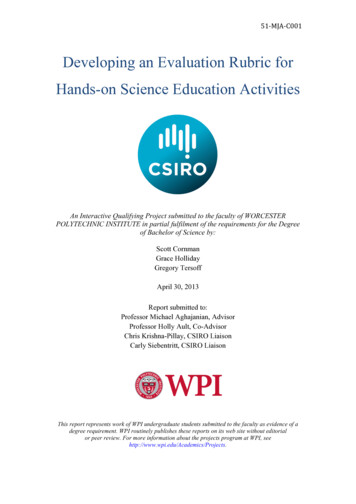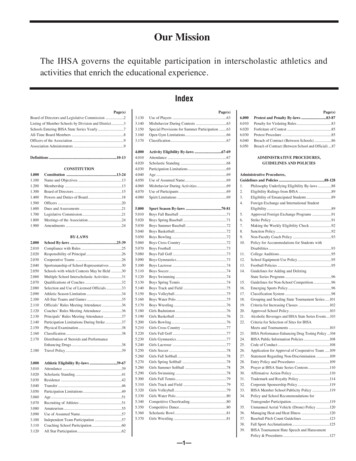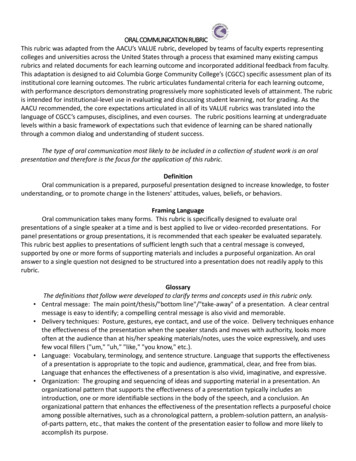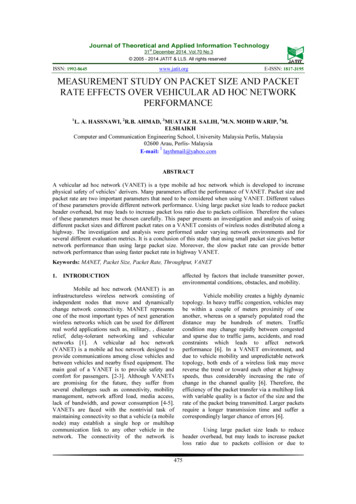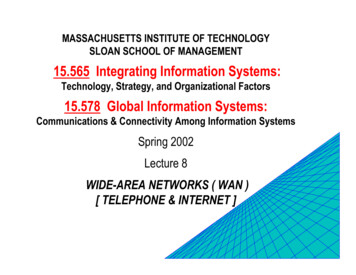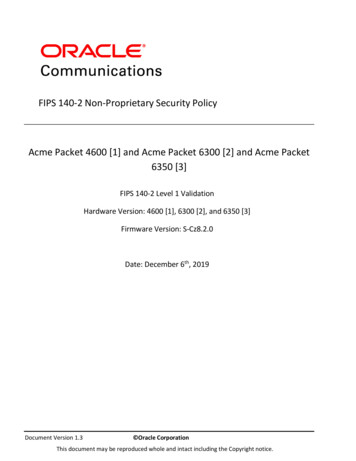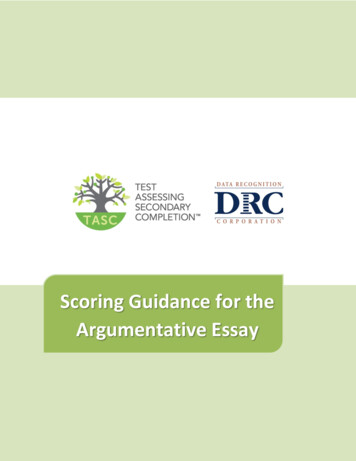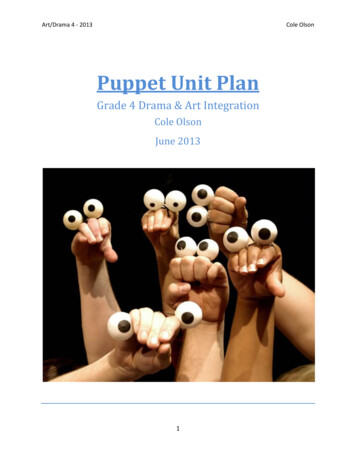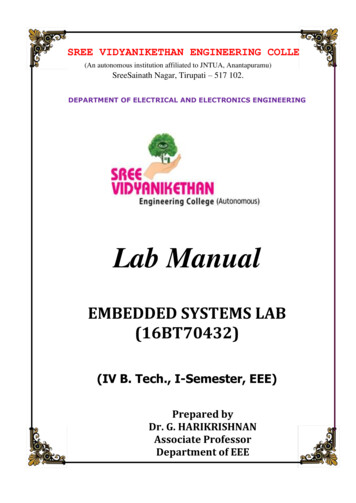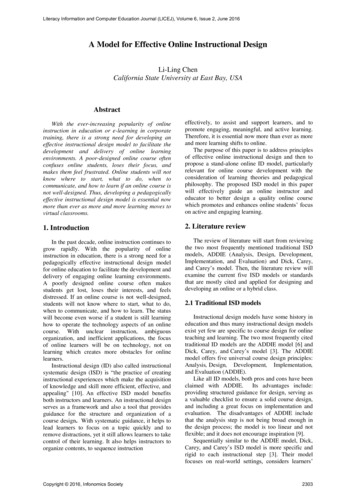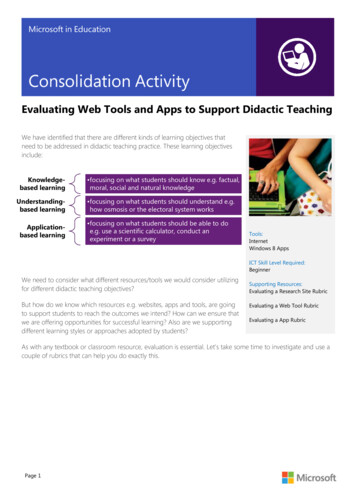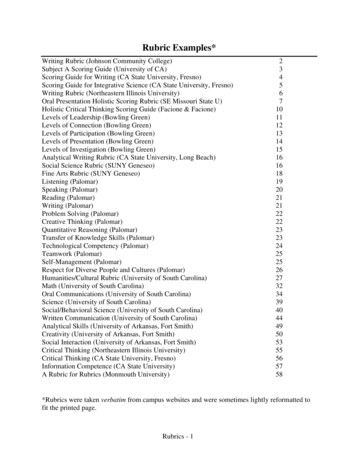
Transcription
Rubric Examples*Writing Rubric (Johnson Community College)Subject A Scoring Guide (University of CA)Scoring Guide for Writing (CA State University, Fresno)Scoring Guide for Integrative Science (CA State University, Fresno)Writing Rubric (Northeastern Illinois University)Oral Presentation Holistic Scoring Rubric (SE Missouri State U)Holistic Critical Thinking Scoring Guide (Facione & Facione)Levels of Leadership (Bowling Green)Levels of Connection (Bowling Green)Levels of Participation (Bowling Green)Levels of Presentation (Bowling Green)Levels of Investigation (Bowling Green)Analytical Writing Rubric (CA State University, Long Beach)Social Science Rubric (SUNY Geneseo)Fine Arts Rubric (SUNY Geneseo)Listening (Palomar)Speaking (Palomar)Reading (Palomar)Writing (Palomar)Problem Solving (Palomar)Creative Thinking (Palomar)Quantitative Reasoning (Palomar)Transfer of Knowledge Skills (Palomar)Technological Competency (Palomar)Teamwork (Palomar)Self-Management (Palomar)Respect for Diverse People and Cultures (Palomar)Humanities/Cultural Rubric (University of South Carolina)Math (University of South Carolina)Oral Communications (University of South Carolina)Science (University of South Carolina)Social/Behavioral Science (University of South Carolina)Written Communication (University of South Carolina)Analytical Skills (University of Arkansas, Fort Smith)Creativity (University of Arkansas, Fort Smith)Social Interaction (University of Arkansas, Fort Smith)Critical Thinking (Northeastern Illinois University)Critical Thinking (CA State University, Fresno)Information Competence (CA State University)A Rubric for Rubrics (Monmouth 32425252627323439404449505355565758*Rubrics were taken verbatim from campus websites and were sometimes lightly reformatted tofit the printed page.Rubrics - 1
Writing RubricJohnson Community College, downloaded 12/22/04 t/cogout/comwrite6 Essay demonstrates excellent composition skills including a clear and thought-provoking thesis,appropriate and effective organization, lively and convincing supporting materials, effective dictionand sentence skills, and perfect or near perfect mechanics including spelling and punctuation. Thewriting perfectly accomplishes the objectives of the assignment.5 Essay contains strong composition skills including a clear and thought-provoking thesis, althoughdevelopment, diction, and sentence style may suffer minor flaws. Shows careful and acceptable use ofmechanics. The writing effectively accomplishes the goals of the assignment.4 Essay contains above average composition skills, including a clear, insightful thesis, althoughdevelopment may be insufficient in one area and diction and style may not be consistently clear andeffective. Shows competence in the use of mechanics. Accomplishes the goals of the assignment withan overall effective approach.3 Essay demonstrates competent composition skills including adequate development and organization,although the development of ideas may be trite, assumptions may be unsupported in more than onearea, the thesis may not be original, and the diction and syntax may not be clear and effective.Minimally accomplishes the goals of the assignment.2 Composition skills may be flawed in either the clarity of the thesis, the development, or organization.Diction, syntax, and mechanics may seriously affect clarity. Minimally accomplishes the majority ofthe goals of the assignment.1 Composition skills may be flawed in two or more areas. Diction, syntax, and mechanics areexcessively flawed. Fails to accomplish the goals of the assignment.Revised October 2003Rubrics - 2
Subject A Scoring Guide (University of California)In holistic reading, raters assign each essay to a scoring category according to its dominant characteristics. Thecategories below describe the characteristics typical of papers at six different levels of competence. All thedescriptions take into account that the papers they categorize represent two hours of reading and writing, not a moreextended period of drafting and revision.Score 6A 6 paper commands attention because of its insightful development and mature style. It presentsa cogent analysis of or response to the text, elaborating that response with well-chosen examplesand persuasive reasoning. The 6 paper shows that its writer can usually choose words aptly, usesophisticated sentences effectively, and observe the conventions of written English.Score 5A 5 paper is clearly competent. It presents a thoughtful analysis of or response to the text,elaborating that response with appropriate examples and sensible reasoning. A 5 paper typicallyhas a less fluent and complex style than a 6, but does show that its writer can usually choosewords accurately, vary sentences effectively, and observe the conventions of written English.Score 4A 4 paper is satisfactory, sometimes marginally so. It presents an adequate analysis of orresponse to the text, elaborating that response with sufficient examples and acceptable reasoning.Just as these examples and this reasoning, will ordinarily be less developed than those in 5papers, so will the 4 paper's style be less effective. Nevertheless, a 4 paper shows that its writercan usually choose words of sufficient precision, control sentences of reasonable variety, andobserve the conventions of written English.Score 3A 3 paper is unsatisfactory in one or more of the following ways. It may analyze or respond tothe text illogically; it may lack coherent structure or elaboration with examples; it may reflect anincomplete understanding of the text or the topic. Its prose is usually characterized by at leastone of the following: frequently imprecise word choice; little sentence variety; occasional majorerrors in grammar and usage, or frequent minor errors.Score 2A 2 paper shows serious weaknesses, ordinarily of several kinds. It frequently presents asimplistic, inappropriate, or incoherent analysis of or response to the text, one that may suggestsome significant misunderstanding of the text or the topic. Its prose is usually characterized by atleast one of the following: simplistic or inaccurate word choice; monotonous or fragmentedsentence structure; many repeated errors in grammar and usage.Score 1A 1 paper suggests severe difficulties in reading and writing conventional English. It maydisregard the topic's demands, or it may lack any appropriate pattern of structure or development.It may be inappropriately brief. It often has a pervasive pattern of errors in word choice, sentencestructure, grammar, and ja.htmRubrics - 3
California State University, FresnoScoring Guide for WritingScoring Level4- Accomplished3- Competent2- Developing1- BeginningKnowledge of ConventionsIn addition to meeting the requirementsfor a “3,” the writing is essentially errorfree in terms of mechanics. Models thestyle and format appropriate to theassignment.While there may be minor errors, thepaper follows normal conventions ofspelling and grammar throughout and hasbeen carefully proofread. Appropriateconventions for style and format are usedconsistently throughout the writingsample. Demonstrates thoroughness andcompetence in documenting sources; thereader would have little difficultyreferring back to cited sources.Frequent errors in spelling, grammar(such as subject/verb agreements andtense), sentence structure and/or otherwriting conventions distract the reader.Writing does not consistently followappropriate style and/or format. Sourcedocumentation is incomplete. It may beunclear which references are direct quotesand which are paraphrased.Writing contains numerous errors inspelling, grammar, and/or sentencestructure which interfere withcomprehension. Style and/or format areinappropriate for the assignment. Fails todemonstrate thoroughness andcompetence in documentation.Clarity and CoherenceRhetorical ChoicesIn addition to meeting therequirements for a “3,” writing flowssmoothly from one idea to another.The writer has taken pains to assistthe reader in following the logic ofthe ideas expressed.Sentences are structured and word arechosen to communicate ideas clearly.Sequencing of ideas withinparagraphs and transitions betweenparagraphs make the writer’s pointseasy to follow.In addition to meeting the requirementsfor a “3,” the writer’s decisions aboutfocus, organization, style/tone, andcontent made reading a pleasurableexperience. Writing could be used as amodel of how to fulfill the assignment.The writer has made good decisionsabout focus, organization, style/tone,and content to communicate clearly andeffectively. The purpose and focus ofthe writing are clear to the reader andthe organization and content achieve thepurpose well. Writing follows allrequirements for the assignment.Sentence structure and/or word choicesometimes interfere with clarity.Needs to improve sequencing of ideaswithin paragraphs and transitionsbetween paragraphs to make thewriting easy to follow.The writer’s decisions about focus,organization, style/tone, and/or contentsometimes interfere with clear, effectivecommunication. The purpose of thewriting is not fully achieved. Allrequirements of the assignment may notbe fulfilled.Sentence structure, word choice, lackof transitions and/or sequencing ofideas make reading and understandingdifficult.The writer’s decisions about focus,organization, style/tone, and/or contentinterfere with communication. Thepurpose of the writing is not achieved.Requirements of the assignment havenot been fulfilled.June 6, 2002http://www.csufresno.edu/cetl/assessment/ (click on WritingScoring.doc)Rubrics - 4
California State University, FresnoGeneral Education Scoring Guide for Integrative ScienceScoring LevelScience and SocietyBasic Concepts andFundamentalPrinciplesScientific ApproachNature of Science4 - AccomplishedDevelops and defends aninformed position,integrating values,science, and technology.Integrates and appliesbasic scientificconcepts andprinciples.Demonstratescomprehension of thescientific approach;illustrates with examplesDemonstrates scientificreasoning across multipledisciplines.3 - CompetentCorrectly describesperspectives concerningthe scientific aspects of asocietal issue.Shows clearcomprehension ofbasic scientificconcepts andprinciples.Accurately expressesconcepts relating to thescientific approachInterprets and relatesscientific results in a waythat shows a clearrecognition of the nature ofscience.2 - DevelopingRecognizes the place ofscience in human affairs,but is unable tocommunicate its roles.Able to state basicscientific conceptsand principles.Uses vocabulary relatedto scientific methods in arote manner or showingsimple conceptualizationProvides simplistic orincomplete explanations ofthe nature of science.1 - BeginningDoes not visualize a roleor need for science inhuman affairs.Lacks understandingof basic scientificconcepts andprinciples.Shows minimalunderstanding ofscientific methodsDoes not distinguishbetween scientific,political, religious, orethical t/ (click on IBScoring.doc)Rubrics - 5
Writing RubricNortheastern Illinois University(adapted from: Barbara Walvoord, Winthrop Univ., Virginia Community College System, Univ. of e ProficiencyProficiency1. Thesis/Focus:(a) OriginalityThesis is missingThesis may be obvious orunimaginativeThesis is somewhatoriginal2. Thesis/Focus:(b) ClarityReader cannot determinethesis & purpose ORthesis has no relation tothe writing taskUnclear organization ORorganizational plan isinappropriate to thesis.No transitionsThesis and purpose aresomewhat vague OR onlyloosely related to the writingtaskSome signs of logicalorganization. May haveabrupt or illogical shifts &ineffective flow of ideasThesis and purpose arefairly clear and match thewriting taskOffers simplistic,undeveloped, or crypticsupport for the ideas.Inappropriate or off-topicgeneralizations, faultyassumptions, errors offactNeglects importantsources. Overuse ofquotations or paraphraseto substitute writer’s ownideas. (Possibly usessource material withoutacknowledgement.)Offers somewhat obvioussupport that may be toobroad. Details are too general,not interpreted, irrelevant tothesis, or inappropriatelyrepetitive3. Organization4. Support/Reasoning(a) Ideas(b) Details5. Use ofsources/DocumentationUses relevant sources butlacks in variety of sourcesand/or the skillfulcombination of sources.Quotations & paraphrasesmay be too long and/orinconsistently referencedhttp://www.neiu.edu/ neassess/gened.htm#rubricRubrics - 6Organization supportsthesis and purpose.Transitions are mostlyappropriate. Sequence ofideas could be improvedOffers solid but lessoriginal reasoning.Assumptions are notalways recognized ormade explicit. Containssome appropriate detailsor examplesUses sources to support,extend, and inform, butnot substitute writer’sown development of idea.Doesn’t overuse quotes,but may not alwaysconform to required stylemanualHigh ProficiencyDevelops fresh insight thatchallenges the reader’sthinking;Thesis and purpose areclear to the reader; closelymatch the writing taskFully & imaginativelysupports thesis & purpose.Sequence of ideas iseffective. Transitions areeffectiveSubstantial, logical, &concrete development ofideas. Assumptions aremade explicit. Details aregermane, original, andconvincingly interpretedUses sources to support,extend, and inform, but notsubstitute writer’s owndevelopment of idea.Combines material from avariety of sources, incl.pers. observation, scientificdata, authoritativetestimony. Doesn’t overusequotes.(Rating)
Oral Presentation Holistic Scoring RubricSoutheast Missouri State UniversityRetrieved September 3, 2005 from http://ustudies.semo.edu/oralcom/holistic.htmSCORE 6Designates a Clearly Excellent speech.A. Focus: the thesis is very clearly stated; the topic is narrowed sufficiently; the specificaudience has clearly been taken into account when delivering the speechB. Organization: the speech has a clear introduction that catches the audience’s attentioneffectively and is connected to the whole; effective transitions recap each main point; theconclusion effectively summarizes the speech and is related to the wholeC. Development: all main points begin with a clear topic sentence; all main and supportingpoints are supported by specific and highly effective examples/evidence; the main andsupporting points all relate to each otherD. Style: language is memorable; language usage is felicitous; tone is appropriateE. Delivery: eye contact is effectively established with the audience; gestures and paralinguisticcues are used to reinforce particularly important ideas; no excessive use of vocalized pauses(e.g., “ah, um”); student is extremely articulateF. References: outside sources and incorporated logically, insightfully, and elegantly; sourcesare documented accuratelySCORE 5Designates a Still Impressive speech.A. Focus: the thesis is clearly stated; the topic is limited; the specific audience has clearly beenconsidered when delivering the speechB. Organization: the introduction catches the audience’s attention and is connected to the whole;transitions signal movement to another point; the conclusion is clean and related to the wholeC. Development: almost all main points begin with a clear topic sentence; the main andsupporting points include concrete, specific evidence/examples; almost all the main andsupporting points relate to each otherD. Style: most language is memorable; language usage is accurate; tone is appropriateE. Delivery: eye contact is established with the audience; gestures and paralinguistic cues aremostly used to reinforce particularly important ideas; some vocalized pauses are used;student is articulateF. References: source material is used logically and proficiently; sources are accuratelydocumentedSCORE 4Designates an Adequate speech.A. Focus: the thesis is clear or clearly implicit; the topic is partially limited; it is implied that thespecific audience has been considered when delivering the speechB. Organization: the introduction and conclusion are clear and somewhat related to the whole;some transitions are usedC. Development: some main points begin with a clear topic sentence; some main and supportingpoints include specific evidence/examples; most main and supporting points relate to eachotherRubrics - 7
D. Style: most language is somewhat memorable; language usage is correct; tone is usuallyappropriateE. Delivery: eye contact with the audience is somewhat established; gestures and paralinguisticcues are sometimes used to reinforce particularly important ideas; several vocalized pausesare used; student is somewhat articulateF. References: source material is incorporated logically and adequately; sources are documentedaccurately for the most partNON-MASTERY SCORESSCORE 3Designates a Developing speechA. Focus: the thesis is unclear; the topic is only partially limited; the specific audience has beenpartially considered when delivering the speechB. Organization: the introduction and conclusion may be ineffective and not related to thewhole; the logical plan must be inferred, as no transitions are usedC. Development: some main points have stated or implied topic sentences; some main points aresupported by specific evidence/examples; some main and supporting points relate to eachotherD. Style: language is not very memorable; language usage is generally accurate; tone is ofteninappropriateE. Delivery: eye contact with the audience is hardly established; gestures and paralinguistic cuesare seldom used to reinforce particularly important ideas; vocalized pauses are usedfrequently; student is not very articulateF. References: source material is incorporated but sometimes inappropriately or unclearly;sources are documented accurately only occasionallySCORE 2Designates a Rudimentary speech.A. Focus: the thesis is unclear; the topic is not limited; the specific audience has beenconsidered vaguely when delivering the speechB. Organization: the introduction and conclusion are ineffective and not related to the whole;the logical plan must be inferred, as no transitions are usedC. Development: few main points have stated or implied topic sentences; few main points aresupported by specific evidence/examples; supporting material is imprecise, unclear, orredundant; few main and supporting points relate to each otherD. Style: language is not memorable; language usage is inaccurate; tone is inappropriateE. Delivery: almost no eye contact with the audience; gestures and paralinguistic cues areseldom used to reinforce particularly important ideas; vocalized pauses are used frequently;student is not very articulateF. References: source material is inappropriately or unclearly incorporated; documentation isinfrequentSCORE 1Designates an Incoherent speechA. Focus: the topic and thesis are unclear; no apparent attempt has been made to limit the topic;the specific audience has not been considered at allB. Organization: no attempt has been made to compose an effective introduction or conclusion;these is no logical plan to the speechRubrics - 8
C. Development: main points contain no topic sentences; main points are not supported byspecific examples/evidence; little or no supporting material is used; main and supportingpoints do not relate to each otherD. Style: language is not memorable or is confusing; language usage is inaccurate; tone isinappropriate or distractingE. Delivery: no eye contact is made with the audience; gestures and paralinguistic cues are notused to reinforce particularly important ideas; vocalized pauses are used in abundance anddistract from the overall messageF. References: source material is never incorporated or incorporated inappropriately orunclearly; documentation is inaccurateSCORE 0Designates a speech that has clearly not been developed on the assigned topic or makes noattempt to answer the given question or relate to the given topic.This rubric is based upon the scoring rubric used by the Writing Outcomes Program at SoutheastMissouri State University.Rubrics - 9
Holistic Critical Thinking Scoring RubricFacione and Facione4321Consistently does all or almost all of the following:Accurately interprets evidence, statements, graphics, questions, etc.Identifies the salient arguments (reasons and claims) pro and con.Thoughtfully analyzes and evaluates major alternative points of view.Draws warranted, judicious, non-fallacious conclusions.Justifies key results and procedures, explains assumptions and reasons.Fair-mindedly follows where evidence and reasons lead.Does most or many of the following:Accurately interprets evidence, statements, graphics, questions, etc.Identifies relevant arguments (reasons and claims) pro and con.Offers analyses and evaluations of obvious alternative points of view.Draws warranted, non-fallacious conclusions.Justifies some results or procedures, explains reasons.Fair-mindedly follows where evidence and reasons lead.Does most or many of the following:Misinterprets evidence, statements, graphics, questions, etc.Fails to identify strong, relevant counter-arguments.Ignores or superficially evaluates obvious alternative points of view.Draws unwarranted or fallacious conclusions.Justifies few results or procedures, seldom explains reasons.Regardless of the evidence or reasons, maintains or defends views based onself-interest or preconceptions.Consistently does all or almost all of the following:Offers biased interpretations of evidence, statements, graphics, questions,information, or the points of view of others.Fails to identify or hastily dismisses strong, relevant counter-arguments.Ignores or superficially evaluates obvious alternative points of view.Argues using fallacious or irrelevant reasons, and unwarranted claims.Does not justify results or procedures, nor explain reasons.Regardless of the evidence or reasons, maintains or defends views based onself-interest or preconceptions.Exhibits close-mindedness or hostility to reason.(c) 1994, Peter A. Facione, Noreen C. Facione, and The California Academic Press. 217 La CruzAve., Millbrae, CA 94030.Permission is hereby granted to students, faculty, staff, or administrators at public or nonprofiteducational institutions for unlimited duplication of the critical thinking scoring rubric, ratingform, or instructions herein for local teaching, assessment, research, or other educational andnoncommercial uses, provided that no part of the scoring rubric is altered and that "Facione andFacione" are cited as authors.Retrieved September 2, 2005 from http://www.insightassessment.com/pdf files/rubric.pdfRubrics - 10
Levels of LeadershipBowling Green University, http://folios.bgsu.edu/assessment/Rubrics.htm, downloaded March 21, 2002“Leading” involves guiding a group to achieve its goal. It does not require formal authority orpower, but is more a matter of influence, integrity, spirit, and respect. Leadership quality inthis course will be evaluated using the features defining the four levels shown below.Level 1 Leadership (Beginner) Gives an impression of reluctance or uncertainty about exercising leadership Focuses exclusively on the task to be accomplished without regard to the people, or focusesexclusively on the interpersonal relations and attitudes of people in the group without regardto the task Asks for ideas or suggestions without intending to consider them May show favoritism to one or more group members Takes the group off trackLevel 2 Leadership (Novice) Shows occasional signs of insecurity about leading, or is overly confident about ownleadership skills Gives too much attention to the task or to interpersonal relations in the group Asks for ideas and suggestions but neglects to consider them Lets the group ramble or stray off track too much, or keeps the group so rigidly on track thatrelevant issues or concerns are ignored Has an agenda and goals for the groupLevel 3 Leadership (Proficient) Looks comfortable and confident in exercising leadership duties Circulates a prepared agenda in advance Balances the need for task accomplishment with the needs of individuals in the group Listens actively and shows understanding by paraphrasing or by acknowledging and buildingon others’ ideas Shows respect to all group members Shares information openly Assigns tasks by seeking volunteers, delegating as needed Checks for agreement, acceptance, buy-in Gives recognition and encouragementLevel 4 Leadership (Advanced)All of the positive features of proficient leadership, plus: Engages all group members Keeps the group on track by managing time, providing coaching or guidance, using humor,or resolving differences, as needed Intervenes when tasks are not moving toward goals Involves the group in setting challenging goals and planning for their accomplishment Helps others to provide leadershipRubrics - 11
Levels of ConnectionBowling Green University, nect.htm“Connecting” is the essence of creative problem solving, shown in synthesizing knowledgewithin and across courses, integrating theory and practice, linking academic and lifeexperiences, and relating one’s self and culture to diverse cultures within the U.S. and globally.The quality of connections made in course assignments will be evaluated using the featuresdefining the four levels shown below. Level 1 Connection (Beginner)Describe similarities and differences in a collection or set of itemsCategorize items or observations into groupsRecognize simple links among topics or concepts in a courseOffer accurate definitions of terms and conceptsDescribe the setting (e.g., context, environment, culture, domain) in which connections arebeing madeLevel 2 Connection (Novice)Organize groups of items into ordered collections and specify the organizing principle(s)Recognize links among topics and concepts presented in different coursesRelate and use information from other courses or experiences in the current settingFormulate generalizations about collections or sets of itemsDistinguish concrete and abstract representationsIdentify disciplinary concepts (theories, frameworks) and instances of their applicationLevel 3 Connection (Proficient)Use disciplinary frameworks and concepts to illuminate relationships among apparentlydiverse itemsExamine phenomena from multiple viewpoints, both concretely and abstractlySpecify the limits or boundaries within which generalizations applyApply abstract academic knowledge to solve concrete practical problemsLevel 4 Connection (Advanced)Identify ways to reconcile diverse or conflicting priorities, viewpoints, or options.Call attention to something that has not been adequately noticed by others (e.g., a subtle ordeep relationship, novel findings or interpretations, the context or frame of reference)Apply frameworks from multiple domains of knowledge and practice to create something(e.g., business plan, musical composition, thesis, capstone paper, research project)Integrate diverse elements into a product, performance or artifact that fits its contextcoherentlyRubrics - 12
Levels of ParticipationBowling Green University, /Particip.htm“Participating” is a matter of active engagement, rather than passive observation, and is shownthrough working effectively in diverse groups and teams, as well as through cooperation and respectfor others. Participation quality in this course will be evaluated using the features defining the fourlevels shown below.Level 1 Participation (Beginner) Little or no advance preparation Lets others set and pursue the agenda Observes passively and says little or nothing Responds to questions Gives the impression of wanting to be somewhere else Attendance record is haphazard and inconsistent; may be absent or late without noticeLevel 2 Participation (Novice) Moderately prepared in advance Takes some part in setting group goals and agendas Participates in discussions, letting others provide the direction Occasionally introduces information or asks questions If likely to be absent or late, informs others ahead of time and arranges to cover ownresponsibilitiesLevel 3 Participation (Proficient) Well prepared in advance Takes a large part in setting group goals and agendas Actively participates in discussion and asks questions Listens actively and shows understanding by paraphrasing or by acknowledging and buildingon others’ ideas Volunteers willingly and carries own share of the group’s responsibilitiesLevel 4 Participation (Advanced) All of the markers of proficient participation, plus: Draws out ideas or concerns of others, especially those who have said little Re-visits issues or ideas that need more attention Helps the group stay on track Summarizes group decisions and action assignmentsRubrics - 13
Levels of PresentationBowling Green University, sent.htm“Presenting” requires fluency not only in English or another language, but often also in othersymbol systems, such as logical, mathematical, visual, spatial, musical, electronic, or gestures andmovements. Speaking quality for course presentations will be evaluated using the features definingthe four levels shown below.Level 1 Presenting (Beginner)Ill-defined or no announced purpose Unfocused sense of audience Inadequate organization and/or development Inappropriate or insufficient details to support ideas Does not demonstrate understanding of topic beyond a surface level Looks only at notes or away from audience Vocal qualities (pace, inflection, volume, enunciation) distract from the content Lacks interest in the topicLevel 2 Presenting (Novice) Vague purpose or multiple
Writing Rubric (Johnson Community College) 2 Subject A Scoring Guide (University of CA) 3 Scoring Guide for Writing (CA State University, Fresno) 4 Scoring Guide for Integrative Science (CA State University, Fresno) 5 Writing Rubric (Northeastern Illinois University) 6 Oral Presentation Holistic Scoring Rubric (SE Missouri State U) 7
